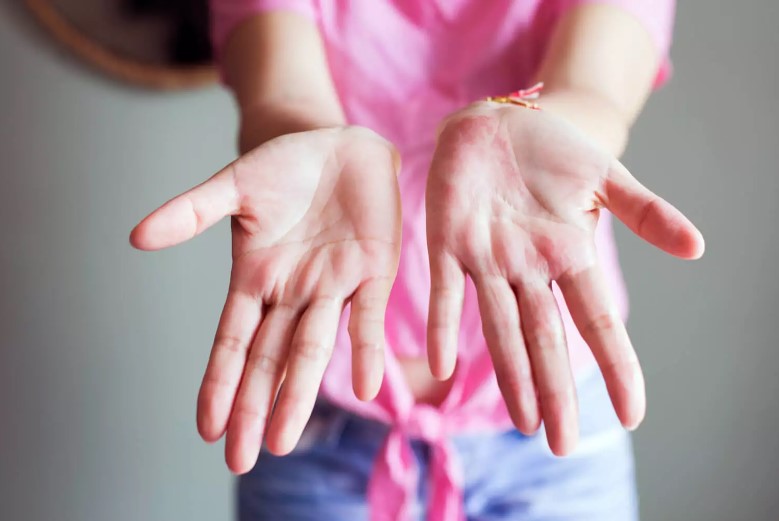Palmar erythema, often dubbed “liver palms,” is hyperpigmentation in both of the palms. Reddening usually starts at the heel of the hand, although it can occasionally go all the way up to the fingers. The condition of having redness on the soles of the feet is known as plantar erythema.
When touched, the skin will become pale and may seem red, similar to a rash. Several variables, including a person’s body temperature, level of physical activity, and even their mental condition, can affect how red they are, including their emotional state.
There is no danger associated with palmar erythema. Although there may be no underlying cause, it generally results from another medical problem.
Risk Factors And Causes
The palms of the hands turn red as a result of dilated capillaries in the hand that push more blood to the surface. The majority of medical experts concur that hormonal changes are to blame for palmar erythema.
There are a number of underlying risk factors and causes that may be involved in palmar erythema, depending on the type of erythema.
Primary Palmar Erythema
Primary palmar erythema, a physical symptom, is not a result of another condition. A few things increase the likelihood of getting the illness.
Primary palmar erythema frequently develops during pregnancy. Pregnant women’s bodies produce more oestrogen because of the hormonal changes that occur during pregnancy.
Those with higher oestrogen levels may be more susceptible to palmar erythema. Because this oestrogen increase is only temporary, the erythema in the hands will likely go away after the pregnancy.
In a few rare instances, primary palmar erythema may be hereditary in origin. If someone has close family members who suffer from the condition, they may be more prone to getting palmar erythema themselves. Redness in the palms can develop at birth or later in life and last for the rest of one’s life. Even though there have been a few isolated cases reported, at least two family members may be impacted.
There have been no reports linking the palmar erythema to any signs of an allergic reaction, inflammation, or other illnesses. Only a few cases of inherited palmar erythemas have been described since they were first identified in medical journals. Idiopathic palmar erythemas are also possible. This shows that the symptom has no known cause and that doctors have been unable to determine its underlying cause.
Subsequent Palmar Erythema
Palmar erythema is frequently the first symptom of a medical problem and is frequently accompanied by secondary symptoms of other disorders.While some liver disorders are inherited, others may be influenced by dietary and lifestyle choices, such as drinking alcohol.
Liver Conditions Linked To Palmar Eythra
Your liver tries to heal itself after a serious injury, but scar tissue replaces the healthy liver tissue. This condition is known as cirrhosis.
Other liver conditions linked to palmar erythema comprise hereditary hemochromatosis, in which your body over-absorbs iron from your diet; uncommon conditions include Wilson disease, an inherited condition in which excessive copper builds in your system.
Some drugs may potentially result in palmar erythema, according to the individual’s liver condition. A doctor will frequently ask a patient about any medications they are taking when making a diagnosis to see if the illness is a side effect of any particular drugs.
The redness in the hands could be caused by other disorders. These incorporate:
- Thyrotoxicosis,
- HIV and autoimmune diseases such as rheumatoid arthritis
- , endocrine disorders like diabetes,
- hepatitis C,
- skin conditions such as eczema or atopic dermatitis,
- illnesses caused by bacteria or viruses
- a metastatic brain cancer caused by long-term smoking
Children’s palmar erythema may be a symptom of a variety of diseases. The most typical of these ailments are:
- born with syphilis
- liver and pulmonary hypertension due to
- Wilson disease
- poisoning
- Kawasaki illness
A hereditary tendency may potentially cause palmar erythema in children.
Symptoms of Palmar Erythema
Palmar erythema manifests as redness on the hands’ palms. Both hands have this redness, which is neither unpleasant nor irritating.
Several individuals may discover that while their hands are not inflamed or swollen, they feel somewhat warmer. The illness could extend to the fingers but not to any other part of the body.
Although palmar erythema typically has no accompanying symptoms, depending on the underlying illness, additional symptoms may appear all over the body.
Diagnosis Of Palmar Erythema
In some circumstances, MRI or CT scans could be necessary to diagnose an underlying problem.
Examining the palms helps doctors identify palmar erythema with ease. To rule out any further causes of the disease, doctors will also do a comprehensive examination.
In order to make a diagnosis, a doctor will review the patient’s medical past. They may also ask if the condition has affected any members of the patient’s immediate family.
In order to help validate their diagnosis, doctors often conduct one or more tests. This may involve assessments that gauge:
- levels of fasting glucose and liver function
- total number of blood cells
- an infection with hepatitis B or C
- thyroid activity
- copper or iron levels
- nitrogen urea in blood
- levels of blood creatine
A physician may also request imaging tests, such as a computed tomography (CT) scan or magnetic resonance imaging, depending on the probable etiology of the palmar erythema (MRI). They could request a bone marrow biopsy in some circumstances.
In the event that the outcomes of initial testing do not corroborate a doctor’s diagnosis, a patient might need to undergo additional testing. This is essential to do in order to identify any underlying issues that might pose a serious risk to your health.
Doctors will only conclude that palmar erythema is idiopathic after ruling out all other possibilities.
Treatment For Palmar Erythema
The palmar erythema that causes red palms has no specific remedy. The treatment plan must include identifying and addressing the condition’s underlying cause. The redness in the palms may disappear once the underlying reason has been addressed.
Red palms brought on by palmar erythema are not curable with any particular medication. In order to treat a problem, the underlying cause must be identified and addressed. The redness in the palms may lessen or disappear completely once the underlying cause has been addressed.simultaneously, but if there is no underlying cause for them, they are not harmful. If palmar erythema is chronic, it is usually a good idea to visit a doctor on a regular basis.
Resources
American Family Physician: “Common Skin Conditions During Pregnancy.”
American Journal of Clinical Dermatology: “Palmar Erythema.”
Case Reports in Dermatology: “Erythema Palmare Hereditarium ( Red Palm’, Lane’s Disease’)”
Journal of the American Medical Association: “A NOTE ON PALMAR ERYTHEMA (SO-CALLED LIVER PALMS).”
Journal of Tropical Pediatrics: “Fluctuating Palmar Erythema in a Toddler during COVID-19 Pandemic: Do You Know the Offender?.”













